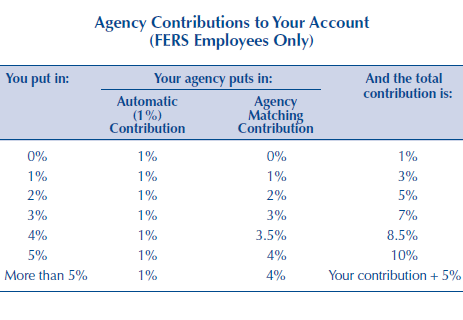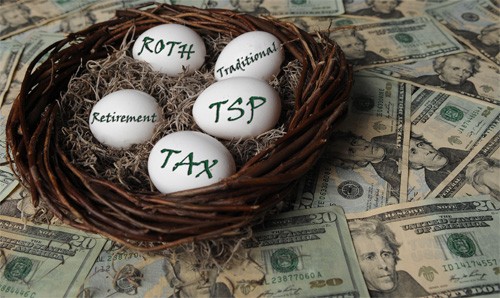Thrift Savings Plan
Post on: 18 Апрель, 2015 No Comment

Thrift Savings Plan
The Federal Thrift Savings Plan. or TSP. is a retirement savings plan for civilians who are, or previously were, employed by the United States Government and for members of the uniformed services. The TSP encompasses many millions of investors and has substantial assets. As of July 2007, the TSP had US$224,000,000,000 among 3.77 million investors. [ 1 ]
The TSP is a defined contribution plan administered by the Federal Retirement Thrift Investment Board. In most ways, the TSP closely resembles the dynamics of 401(k) plans. The retirement assets derived from a TSP account will depend on how much has been contributed to the account (both by the employee, and if applicable, his or her agency) during the account holders working years and the earnings on those contributions. The government will make automatic and matching contributions, for certain (FERS) civilian employees, based on the employees contributions. Employees under the CSRS (Civil Service Retirement System ) may participate in the TSP, but are not eligible for matching contributions. The typical FERS matching formula is: 1% regardless of employee contribution (even if zero), then 1% for each 1% contributed by the employee (to a maximum of 3%), then 0.5% for each 1% contributed by the employee (to an additional 1% match maximum). In other words, the employee may receive up to 1%+3%+1% = 5% matching contributions. Military members are generally not eligible for matching contributions.
Prior to 2006, the amount that could be contributed was limited to a certain percentage of basic pay. In 2006, this percentage limit was removed; the only remaining restriction on contributions is that imposed by the Internal Revenue Service. However, matching contributions, as outlined above, are limited to 5%.
The TSP offers the same type of savings and tax benefits that many private corporations offer their employees under 401(k) and similar plans. TSP regulations are published in title 5 of the Code of Federal Regulations. Parts 1600 — 1690, and are periodically supplemented and amended in the Federal Register .
TSP funds
The TSP offers investors the following choice of funds:
- Individual funds
- G fund [ 2 ] Government Securities fund. These are unique government securities, backed by the full faith and credit of the US Government, available only through the G Fund.
- F Fund [ 3 ] Fixed Income Index fund. Invested in Barclays U.S. Debt Index Fund. Tracks the Lehman Aggregate Bond Index .
- C fund [ 4 ] Common Stock Index fund. Invested in Barclays Equity Index Fund. Tracks the total return version [ 5 ] of the S&P 500 index.
- S Fund [ 6 ] Small Capitalization Stock Index fund. Invested in Barclays Extended Market Index Fund. Tracks the float-adjusted total return version [ 5 ] of the Wilshire 4500 index.
- I Fund [ 7 ] International Stock Index fund. Invested in Barclays EAFE Index Fund. Tracks the net version [ 5 ] of the MSCI EAFE index.

Four of the Individual funds, managed by Barclays Global Investors. are trust funds open only to tax-exempt employee benefit plans. These funds are not mutual funds and are not open to individual investors. As such, there are no tickers for the funds reported in the financial press.
In 2005. the TSP introduced the Lifecycle funds (L2040, L2030, L2020 L2010, L Income), which are composed of percentages of the five Individual funds based on target retirement year. The composition of the L funds will shift more to the G and F Funds as the target years approach. For instance, around 2010. the L2010 fund will be given a makeup similar to the current L Income fund, and an aggressive L2050 fund will be established. These asset shifts are automatic and the advantage of the L funds.
The following percentages indicate the initial breakdown of the L funds at the time of their creation. According to TSP literature, these funds are rebalanced on a quarterly basis, becoming less risky (higher percentage in the G fund), as they eventually align with the initial L Income percentages by their target dates.
- L2040 [ 8 ] 5%G, 10%F, 42%C, 18%S, 25%I
- L2030 [ 9 ] 16%G, 9%F, 38%C, 16%S, 21%I
- L2020 [ 10 ] 27%G, 8%F, 34%C, 12%S, 19%I
- L2010 [ 11 ] 43%G, 7%F, 27%C, 8%S, 15%I
- L Income [ 12 ] 74%G, 6%F, 12%C, 3%S, 5%I
Options and features available to TSP investors
- TSP members may, if they switch to non-governmental employment, roll-over their TSP accounts into qualifying retirement accounts with their new employer.
- It is also possible for those moving into federal employment to roll-over their existing 401(k) into the TSP. The TSP also allows participants who are active employees to move assets from regular IRAs into the plan.
- Any TSP member may change the fund allocation of future contributions at any time. He or she may also redistribute the existing assets into any of the TSP funds at any time which is called an Interfund Transfer or IFT. If the IFT is submitted before 12pm Eastern, then the IFT is effective at close of business that day. If the IFT is submitted after 12pm Eastern, then the IFT is effective at close of business the following day. The Thrift Savings Plan will implement restrictions on the number of interfund transfers a participant can make per month in order to curb frequent trading and its associated costs to TSP participants. However, the TSP does want to provide the opportunity for participants to rebalance their accounts and to permit unrestricted access to the Government Securities Investment (G) Fund. Accordingly, the restrictions would be as follows:
Participants can make two (2) interfund transfers per calendar month. After that, they may only move money from the Fixed Income Index Investment (F) Fund, the Common Stock Index Investment (C) Fund, the Small Capitalization Stock Index Investment (S) Fund, the International Stock Index Investment (I) Fund, and the L Funds to the G Fund. [ 13 ]
- TSP members may, upon retirement, purchase various kinds of annuities with some or all of their account assets.
- TSP members may, during their working years, take out two types of loans against the assets of their account, which must be repaid via payroll deduction at a self-paid interest rate based upon the current G fund return.
- The TSP web site provides account access at all times, including the most recent quarterly participant statements.
- At the employees option, detailed quarterly participant statements may be mailed to the address of record.
- Account information, share prices, and plan news/materials can be obtained at the TSP web site and via the toll-free access number: 1-TSP-YOU-FRST (1-877-986-3778).














